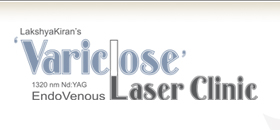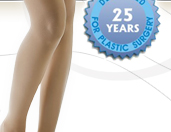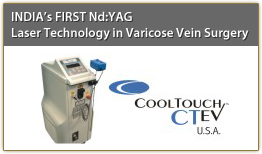| Varicose Veins |
| |
| What are Varicose Veins? |
| Varicose veins are abnormally enlarged, elongated, tortuous superficial veins that may bulge from the surface of the skin and are usually seen in the legs. The condition is known as varicosity and to call an enlarged vein as varicose it needs to be larger than 3 mm in diameter. They can be dark purple or blue and remain harmless for quite a long time. Though most often seen on the inside of the leg and thigh they can be found in other parts of the body. |
|
| Types of Veins |
There are three types of vein systems in the body.
Superficial veins run in the layer of fat just beneath the skin. These are the ones that you normally see on your feet or around the ankles because these body parts are farthest from the heart and most dependent. Superficial veins are most often affected by varicosity and they become visible to the eyes elsewhere on the legs and thighs.
Deep veins are larger blood vessels which are found deep to the leathery layer of fascia surrounding the muscles. They are also present between the muscles and between the groups of muscles and near the bones.
Perforating veins connect the superficial to the deep veins at a number of places in the leg.
They are called perforators because they perforate the leathery fascial layer surrounding the muscles to go and drain in the deeper veins. Normally their valves allow blood to flow only inwards – from the superficial to the deep veins. If the valves stop working properly, then blood is pushed out into the superficial veins when the muscles contract. This is one of the reasons for high pressure in the superficial veins and can be a cause of varicosity.
|
|
| Blood Circulation |
When the left ventricle of the heart pushes oxygen-rich pure blood out into the aorta, it produces a high pressure pulse wave of heartbeat. This pulse pushes the bright red blood first through the aorta then its two branches and continues into sub branches called arteries, arterioles and finally through the capillaries throughout the body. From capillaries to the venules, to veins and then to larger veins is the venous system that carries the oxygen-poor impure blood back to the heart.
Peripheral Heart
The deep veins lead to body's largest vein called the vena cava, which runs directly to the heart. The Calf Muscles act as a booster pump to forcibly push the venous blood from the deep veins towards the heart. Therefore sometimes Calf Muscles are called as a Peripheral Heart. |
|
| The Muscle Pump or Venous Pump |
When you are in the upright position, the blood in your leg veins must work against gravity to return to the heart. To accomplish this, your leg muscles squeeze the deep veins of your feet and legs. One-way flaps, called valves, inside your veins keep blood flowing in the upward direction. When your leg muscles contract, the valves in deep veins open. When your leg muscles relax, the valves close. This prevents blood from flowing in reverse, back down the legs. The entire process of sending blood back to the heart is called the venous pump.
When you walk and your leg muscles squeeze, the venous pump works well. But when you sit or stand, especially for a long time, the blood in your leg veins can pool and the pressure in your veins can increase. Deep veins and perforating veins are usually able to withstand short periods of increased pressures. However, if you are a susceptible individual, your veins can stretch if you repeatedly sit or stand for a long time. This stretching can sometimes weaken the walls of your veins and damage the valves, leading to the varicose veins. |
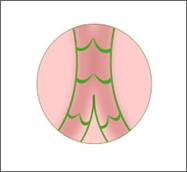 |
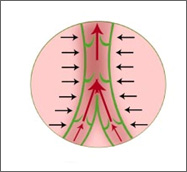 |
| Calf muscle is relaxed. The venous valves remain closed |
Calf muscle is contracted. Blood is pumped up which opens up the venous valves. |
|
| |
|
| Valves in the veins |
On the inner wall of the veins there are delicate one way valves located at regular distance through out the length of veins that open towards the heart in response to the blood flow. Between the heartbeats, there is a period of low blood pressure called diastole. During this low pressure period, blood in the veins is affected by gravity and tends to flow downward in the legs. The valves in the veins close and prevent this from happening. Varicose veins start when one or more valves fail to close completely.
The incompetence of these valves is the basic pathology of varicose veins. The blood pressure in the section of the vein below the incompetent valve increases causing additional valves to fail. This is called ' Venous Hypertension’. When veins become varicose, the leaflets of the valves no longer meet properly, and the valves don't work. This allows blood to flow backwards and they enlarge even more. This allows blood to pool and stretch the vein segments further weakening the walls of the veins. The walls of the affected veins lose their elasticity in response to increased blood pressure. As the vein walls weaken, more and more valves are unable to close properly. The vicious cycle continues and the veins become larger and wider over time and begin to appear as lumpy, tortuous chains underneath the skin. |
| |
 |
 |
| Normal vein with Unidirectional valve |
Competent valve prevents blood from flowing down |
 |
| Because of incompetent valve blood flows down & varicosity develops |
|
| |
|
| Varicose Veins of the Lower Limbs |
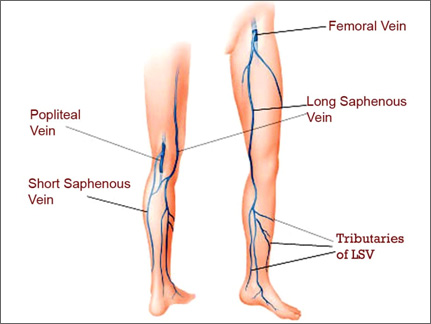 |
| |
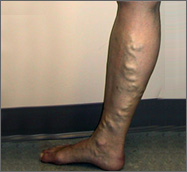 |
In which leg veins varicosities develop? |
Varicosities develop in the Superficial System and in order of occurrence it affects:
- Varicosity of the Great Saphenous Vein. A common cause of varicose veins in the legs is reflux in a thigh vein called the great saphenous, which leads to pooling in the visible varicose vein below.
- Varicosity of the Short Saphenous Vein.
- Atypical Varicose Veins occur in a small group of people. There are net working tributaries to above veins and as such any vein is likely to develop varicosity.
|
|
| |
|
| |
|
|
|
